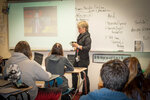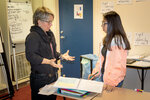

Three years ago Cascade High School embraced a program called AVID to support students who dream of academic success but need guidance to know the steps along that path.
AVID stands for Advancement Via Individual Development and began 35 years ago with one teacher in one classroom. This award-winning program, aimed at underrepresented populations, has snowballed over the years and now impacts 1.5 million students across the nation and in 16 other nations and territories.
AVID came to Cascade because of the vision of Malia Renner-Singer, a social studies teacher. She taught an AVID class at her previous school, Wenatchee High School, and worked with Principal Elia Ala’ilima Daley to start the program at Cascade. In the beginning CHS started with freshman and sophomores. Now about 15 students per grade are enrolled in AVID. Almost all hope to be first generation college students.
Students who opt into the program take an AVID elective class with the same teacher and cohort for all four years. The continuity of a teacher-student relationship and positive support of a peer group represents a key component of AVID.
Andrea Brixey, an English teacher also trained through AVID, leads the freshman and sophomore cohorts, and Renner-Singer leads the juniors and seniors. Daley explained, “In ninth and 10th grades the class focuses on organizational and study skills. In 11th and 12th grades the class helps students prepare and take SATs, write resumes, and prepare to apply for colleges.”
Brixey’s class of AVID sophomores had to think critically from the moment they walked into a recent early morning class. First they watched a snippet of a TED talk about poverty-striken India where kids with minimal formal education taught themselves amazingly complex subjects when given the opportunity (in this case through Sugata Mitra’s research project that installed fully functional computers with internet access in public spaces).
This prompted a discussion. “Why did I show this to you today?” Brixey asked. In her AVID classes Brixey keeps the pace quick. After students discuss their ideas briefly with a partner, she called on them to share answers rather than waiting for raised hands.
This atmosphere creates excitement in the students to keep them actively engaged in the class.
These tenth graders are working on a Passion Project, and on this day they also had to give an impromptu speech about it. After jotting down notes, following the Cornell system of note taking, they wrote a speech about their progress and shared a Point of Confusion (POC), an AVID term used to help them realize what they don’t know so they can strategize how to solve that problem. Students gave their speeches in front of a roundtable of peers, who brainstormed how to help the speaker solve the POC.
Another key element of the AVID class is, Brixey said, “To provide a space for real questions to form. Sometimes my classroom looks messy, sometimes I have to set them loose to struggle a bit to understand what is going on.” She purposefully stirs up cognitive dissonance (a psychological term for when a person is confronted with new information that contradicts his/her previously held beliefs and values) so they start asking questions and forming and validating their own opinions. This works over time because it’s recursive and the students learn self-reliance and confidence.
In Renner-Singer’s class of AVID seniors, they started their day discussing their recent all-day visit to WSU and the pros and cons of the campus. The positives included school spirit, new student building, and diverse programs like nursing, engineering and agriculture, and WSU’s main shortcoming was its remote location. These seniors are in the midst of applying to colleges and about half have WSU on their lists.
Next they prepared for a cornerstone of the AVID curriculum, tutorials. “Tutorials make up about 40% of the AVID class time,” said Renner-Singer. Community volunteers lead the tutorials.
The tutorials follow a specific protocol, beginning with each student filling out a Tutorial Request Form. They write down a challenging question from any of their classes, what they already know about the subject and words and ideas that will help them answer the question. In small groups one student at a time goes through their question. With the help of the group, the student gains understanding and knows how to proceed. The tutors serve as facilitators rather than teachers; they ask probing questions to enable the student to come up with his/her own solution.
One group of five students pondered math and physics equations. Another group helped a student articulate a theme found in Homer’s Iliad.
This day Renner-Singer tasked the seniors with training new tutors. Seniors use tutors less than the lower grades; Renner-Singer slowly removes such supports so they know how to form effective study groups in college. “In the US we’re good at getting kids into college. But not so good at keeping them there,” explained Renner-Singer. “AVID helps assure they stay and get their degrees.”
The AVID elective pays dividends for these twelfth graders. They get extra support for college entrance exams and college and scholarship applications. It makes their final year, which is full of tough classes, sports and jobs, a bit less stressful.
Carmen Herrera and Alondra Zelaya, two AVID seniors, agreed that the senior year AVID class has so far proved to be the best. “We’re like a second family. We’ve gotten closer. We support each other and congratulate each other’s successes,” said Herrera.
Zelaya added, “We’re all going through the same thing and at the same step in the process.”
Daley already has proof of this nascent program’s accomplishments at Cascade. “Currently, among the AVID seniors, 12 of 16 students are taking at least one college level class and 6 of 16 are taking multiple college level classes. Among the juniors the numbers are 15 of 20 taking one such class and 10 of 20 taking two or more.” These students would have formerly avoided college classes but now they are prepared and understand their importance. Daley went on, “From the first to second year, our AVID students’ GPAs rose, and their number of days absent and disciplinary issues decreased.”
Building on this initial achievement, Daley has sent the first waves of teachers to training in San Diego to learn the AVID philosophy and teaching strategies. AVID requiers funding, and so far they’ve received grants from the NCW Community Foundation and Cascade Education Foundation.
There are options to extend AVID’s reach. Icicle River Middle School and Osborn Elementary have teachers piloting AVID techniques with idea that they might be implemented school-wide. The high school will consider whether they want to take the leap to adopt school-wide AVID. A team of staff will visit a couple regional schools, which have adopted that higher level of commitment.
The AVID mission, to grow students who thrive academically, is coming to fruition. When they attend their core classes, the students apply what they’ve learned from the AVID elective. “They take better notes and ask better questions,” said Brixey.
Renner-Singer said, “This year represents our first year of graduating AVID students. It’s special. We see the success in the seniors.” And come graduation time, AVID students will earn a share of the awarded scholarship moneys.
Comments
No comments on this item Please log in to comment by clicking here